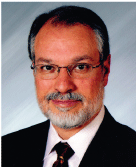This is the second in a series of occasional interviews with O.D.s in the Forefrontoptometrists who are advancing the profession in unique ways.
William V. Padula, O.D., is the founding president of the Neuro-Optometric Rehabilitation Association (NORA).
Q. What is neuro-optometric rehabilitation?

William V. Padula, O.D.
A. Many of the 40 million Americans who have a neurological difficulty also have a related visual processing difficulty that interferes with balance, posture, spatial organization and higher visual cognitive functions. Many of the problems that occur from a neurological condition are due to a dysfunction between the spatial and detail (focal) parts of the visual system.
Doctors trained in neuro-optometric rehabilitation can evaluate and provide treatment for these dysfunctions. An evaluation can determine if the condition is post-trauma vision syndrome (PTVS), which results from a neurological event, such as traumatic brain injury (TBI) or cerebrovascular accident (CVA). Symptoms include blurred vision, spatial disorientation, movement of print or the environment, headaches and asthenopia. Doctors can prescribe special lenses, such as yoked prisms, and occlusion to improve the spatial-visual function.
Posture and balance can also be affected by a dysfunction of the ambient visual process, which causes distortions in the spatial system. This is known as visual midline shift syndrome (VMSS), which can be treated with specially designed yoked prisms along with physical and occupational therapy.
Q. Why is neuro-optometric rehabilitation important?
A. With the increase in CVA among an aging population and the rising incidence of TBI, there is a growing prevalence of PTVS and VMSS. While such patients may receive physical, occupational and speech therapy, as well as rehabilitative psychology and psychiatry, they may also need the interdisciplinary component of neuro-optometric rehabilitation to maximize the potential for rehabilitation.
Recent news items about TBI, caused by improvised explosive devices, among our soldiers in
Q. How can optometrists become more involved?
A. Optometrists should recognize that the numbers of patients with neurological conditions is increasing. O.D.s should also know about PTVS and VMSS to question patients who are unaware that their problems could be caused by a visual processing dysfunction.
Doctors who wish to learn more can visit the Neuro-Optometric Rehabilitation Association Web site at www.nora.cc.

